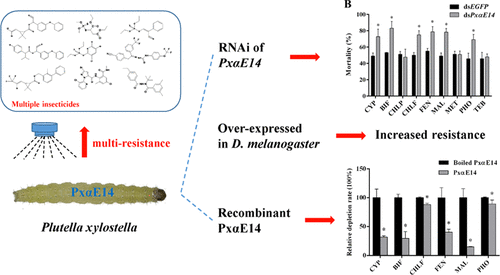当前位置:
X-MOL 学术
›
J. Agric. Food Chem.
›
论文详情
Our official English website, www.x-mol.net, welcomes your
feedback! (Note: you will need to create a separate account there.)
Overexpression of PxαE14 Contributing to Detoxification of Multiple Insecticides in Plutella xylostella (L.)
Journal of Agricultural and Food Chemistry ( IF 5.7 ) Pub Date : 2022-05-05 , DOI: 10.1021/acs.jafc.2c01867 Ran Li 1 , Bin Zhu 1 , Xue-Ping Hu 2 , Xue-Yan Shi 1 , Lin-Lu Qi 1 , Pei Liang 1 , Xi-Wu Gao 1
Journal of Agricultural and Food Chemistry ( IF 5.7 ) Pub Date : 2022-05-05 , DOI: 10.1021/acs.jafc.2c01867 Ran Li 1 , Bin Zhu 1 , Xue-Ping Hu 2 , Xue-Yan Shi 1 , Lin-Lu Qi 1 , Pei Liang 1 , Xi-Wu Gao 1
Affiliation

|
The diamondback moth, Plutella xylostella (L.), has evolved with varying degrees of resistance to almost all major classes of insecticides and has become the most resistant pest worldwide. The multiresistance to different types of insecticides has been frequently reported in P. xylostella, but little is known about the mechanism. In this study, a carboxylesterase (CarE) gene, PxαE14, was found significantly overexpressed in a field-evolved multiresistant P. xylostella population and can be dramatically induced by eight of nine tested insecticides. Results of the real-time quantitative polymerase chain reaction (RT-qPCR) showed that PxαE14 was predominantly expressed in the midgut and malpighian tubule of larvae. Knockdown of PxαE14 dramatically increased the susceptibility of the larvae to β-cypermethrin, bifenthrin, chlorpyrifos, fenvalerate, malathion, and phoxim, while overexpression of PxαE14 in Drosophila melanogaster increased the tolerance of the fruit flies to these insecticides obviously. More importantly, gas chromatography–mass spectrometry (GC–MS) and liquid chromatography–tandem mass spectrometry (LC–MS/MS) assay showed that the recombinant PxαE14 expressed in Escherichia coli exhibited metabolic activity against the six insecticides. The homology modeling, molecular docking, and molecular dynamics simulation analyses showed that these six insecticides could stably bind to PxαE14. Taken together, these results demonstrate that constitutive and inductive overexpression of PxαE14 contributes to detoxification of multiple insecticides involved in multiresistance in P. xylostella. Our findings provide evidence for understanding the molecular mechanisms underlying the multiresistance in insect pests.
中文翻译:

PxαE14 的过表达有助于小菜蛾 (L.) 中多种杀虫剂的解毒
小菜蛾Plutella xylostella (L.) 已进化出对几乎所有主要种类的杀虫剂具有不同程度的抗性,并已成为全球抗药性最强的害虫。P. xylostella经常报道对不同类型杀虫剂的多重耐药性,但对其机制知之甚少。在这项研究中,发现羧酸酯酶 (CarE) 基因PxαE14在田间进化的多抗小菜蛾种群中显着过表达,并且可以被九种测试杀虫剂中的八种显着诱导。实时定量聚合酶链反应 (RT-qPCR) 结果表明,PxαE14主要在幼虫的中肠和马氏管中表达。敲除 PxαE14显着增加了幼虫对 β-氯氰菊酯、联苯菊酯、毒死蜱、氰戊菊酯、马拉硫磷和辛硫磷的敏感性,而黑腹果蝇中 PxαE14 的过表达明显增加了果蝇对这些杀虫剂的耐受性。更重要的是,气相色谱-质谱 (GC-MS) 和液相色谱-串联质谱 (LC-MS/MS) 分析表明,重组 PxαE14 在大肠杆菌中表达表现出对六种杀虫剂的代谢活性。同源性建模、分子对接和分子动力学模拟分析表明,这六种杀虫剂可以与PxαE14稳定结合。总之,这些结果表明PxαE14的组成型和诱导型过表达有助于对小菜蛾多重抗性中涉及的多种杀虫剂的解毒。我们的研究结果为理解害虫多重抗性的分子机制提供了证据。
更新日期:2022-05-05
中文翻译:

PxαE14 的过表达有助于小菜蛾 (L.) 中多种杀虫剂的解毒
小菜蛾Plutella xylostella (L.) 已进化出对几乎所有主要种类的杀虫剂具有不同程度的抗性,并已成为全球抗药性最强的害虫。P. xylostella经常报道对不同类型杀虫剂的多重耐药性,但对其机制知之甚少。在这项研究中,发现羧酸酯酶 (CarE) 基因PxαE14在田间进化的多抗小菜蛾种群中显着过表达,并且可以被九种测试杀虫剂中的八种显着诱导。实时定量聚合酶链反应 (RT-qPCR) 结果表明,PxαE14主要在幼虫的中肠和马氏管中表达。敲除 PxαE14显着增加了幼虫对 β-氯氰菊酯、联苯菊酯、毒死蜱、氰戊菊酯、马拉硫磷和辛硫磷的敏感性,而黑腹果蝇中 PxαE14 的过表达明显增加了果蝇对这些杀虫剂的耐受性。更重要的是,气相色谱-质谱 (GC-MS) 和液相色谱-串联质谱 (LC-MS/MS) 分析表明,重组 PxαE14 在大肠杆菌中表达表现出对六种杀虫剂的代谢活性。同源性建模、分子对接和分子动力学模拟分析表明,这六种杀虫剂可以与PxαE14稳定结合。总之,这些结果表明PxαE14的组成型和诱导型过表达有助于对小菜蛾多重抗性中涉及的多种杀虫剂的解毒。我们的研究结果为理解害虫多重抗性的分子机制提供了证据。











































 京公网安备 11010802027423号
京公网安备 11010802027423号